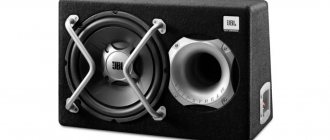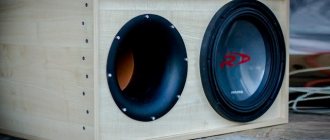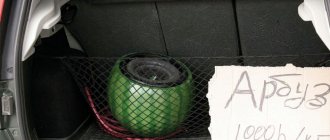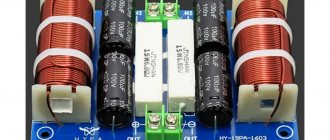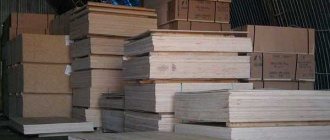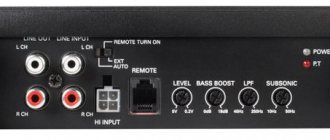Fasteners
For fastening, it is best to use yellow self-tapping screws with a length at least 2 times the wall thickness.
The heads of black ones often break off; they are thinner and not as strong. An advanced solution is furniture bolts, but if this is your first sub, then it will be easier with self-tapping screws. Yellow screws, black screws, furniture bolts.
Cage nuts for attaching the subwoofer to the cabinet are cool! The sub can also be secured with self-tapping screws, but with bolts in the mountings, the speaker is attracted as tightly as possible, and if necessary, it can be removed and installed as many times as necessary without damage. And the polished hex bolts look really cool.
Bolt with cage nut
Video about installing cage nuts (a more convenient option):
Glue
If you are sawing the walls with a jigsaw or a hand-held circular saw, then the glue will additionally act as a sealant between the uneven edges; any liquid wood nails will do for this. If you unraveled the material on the machine and the edges of the body walls are perfect, then apply the glue in a very thin layer, but still do not forget to coat the joints from the inside.
Terminal block
You can route the wires directly, but it is better to make a box for the subwoofer with a terminal block.
Terminal block for housing
Use threaded options - they are more reliable, or choose ones with fairly powerful springs. When installing the terminal block (terminal) for connecting the subwoofer, do not forget to tape the connection point with the housing around the perimeter. For round seats, it is convenient to cut a hole using a nozzle.
Round hole tool
Wires
You will need a piece of wire to connect the subwoofer coil to the output terminal block. Take any copper wire no thinner than 4 mm. in most cases this will be sufficient.
Tools
You will need:
- Circular saw - for cutting material, it can be either manual or stationary, it all depends on your capabilities. It is better not to cut with a jigsaw, the edges will be too uneven, even if you attach a guide bar, since the file can still wander.
Manual circular
- A jigsaw is for cutting out holes for the speaker and for the terminal block, it can also be a router, with its help the holes will be smooth and neat. To cut out the wall for a round terminal block, you can use a saw attachment. Select the right jigsaw blade for the job at hand.
- Screwdriver - for tightening screws and drilling holes.
Preparation
To make a subwoofer enclosure yourself you will need:
- Drawing;
- Materials: plywood or MDF, glue, screws, terminal block, wire for connection;
- Tools - jigsaw, screwdriver, pencil, template for mounting hole or compass.
Drawing
Having the housing parameters for the subwoofer in hand (volume, area and length of the port), you can make a drawing yourself using special programs (in my opinion, SketchUp from Google is the most convenient for this). But if you make the box for yourself, then there is no point in wasting time learning the software and doing everything the old fashioned way - by hand.
If you do not know how to calculate the enclosure, then read the material “How to calculate the enclosure for a subwoofer.” You can also order a paid estimate on the Internet; as a rule, it is accompanied by a clear drawing for manufacturing.
An example of a drawing of a housing with a bass reflex (FI)
Materials and fasteners
Housing material
In order to make a box for a subwoofer, you need a material that should vibrate as little as possible. From experience, it is best to use MDF (not painted, not laminated, etc.)
MDF (MDF - Medium Density Fiberboard). In Russian - medium density fiberboard.
MDF is easy to process, has good density, due to its structure it has no resonances and does not delaminate - the bass in such a box is soft and dense. MDF is more expensive than plywood and is “afraid” of moisture.
Plywood is the most common option and costs less than MDF.
Do not use chipboard or old furniture to make subwoofer boxes. A plywood or MDF body will always sound better.
If the walls are thick enough, there is no need to cover the inside of the body with vibration insulation, etc.!
Do not use material thinner than 18 mm. and the larger the volume of your case, the thicker the walls should be.
Many large stores that sell sheet material offer a cutting service to your dimensions, where they will cut the perfect parts for you on a machine, all that remains is to assemble the body.
Fasteners
For fastening, it is best to use yellow self-tapping screws with a length at least 2 times the wall thickness. The heads of black ones often break off; they are thinner and not as strong. An advanced solution is furniture bolts, but if this is your first sub, then it will be easier with self-tapping screws.
Yellow screws, black screws, furniture bolts.
Cage nuts for attaching the subwoofer to the cabinet are cool! The sub can also be secured with self-tapping screws, but with bolts in the mountings, the speaker is attracted as tightly as possible, and if necessary, it can be removed and installed as many times as necessary without damage. And the polished hex bolts look really cool.
Bolt with cage nut
If you are sawing the walls with a jigsaw or a hand-held circular saw, then the glue will additionally act as a sealant between the uneven edges; any liquid wood nails will do for this. If you unraveled the material on the machine and the edges of the body walls are perfect, then you do not need to use glue; it will be enough to coat the joints from the inside.
Terminal block
You can route the wires directly, but it is better to make a box for the subwoofer with a terminal block.
Terminal block for housing
Use threaded options - they are more reliable. For round seats, it is convenient to cut a hole using a nozzle.
Wires
You will need a piece of wire to connect the subwoofer coil to the output terminal block. Take any copper wire no thinner than 4 mm. in most cases this will be sufficient.
Tools
- Circular saw - for cutting material, it can be either manual or stationary, it all depends on your capabilities. It is better not to cut with a jigsaw, the edges will be too uneven, even if you attach a guide bar, since the file can still wander.
- A jigsaw is for cutting out holes for the speaker and for the terminal block, it can also be a router, with its help the holes will be smooth and neat. To cut out the wall for a round terminal block, you can use a saw attachment. Select the right jigsaw blade for the job at hand.
- Screwdriver - for tightening screws and drilling holes.
What should a subwoofer box be like?
The answer is simple. The main requirement that a subwoofer box must meet is its rigidity and strength. The stiffer the walls, the less vibration the subwoofer creates during operation. Of course, in theory, a box made of a ceramic slab or cast of lead with 15 cm walls would be considered ideal, but of course, this can be considered nonsense, since such subwoofers will not only be expensive to manufacture, but also enormously heavy.
Types and comparison of materials for a subwoofer.
Let's look at real options for materials for making a subwoofer and try to give a short conclusion on each of them.
Plywood
Better moisture resistant. In our opinion, this is one of the most worthy materials for the manufacture of acoustic equipment.
But there are a couple of downsides;
- This is the most expensive material.
- It is difficult to find plywood with a thickness of more than 18 mm.
- If the wall area is large, it begins to “ring” (additional stiffeners or spacers are needed)
MDF
Now it is gaining great popularity. It is a kind of gap between plywood and chipboard. Its main advantage is its lower price than plywood (about the same as chipboard) and good rigidity (but not as good as plywood). Easy to saw. Moisture resistance is higher than that of chipboard.
- It is problematic, but possible to find, a thickness of more than 18 mm.
Chipboard
Cheap, common material. Every furniture company has it, and you can order cutting from the same companies. This box will cost you 2-3 times less than one made from plywood. Flaws:
- Very little rigidity of the material (example about grandma’s closet above).
- Not moisture resistant. Absorbs moisture well and crumbles. It is especially dangerous if water gets into your trunk.
Cutting parts
So, you have decided on the shape for the sub box and you have a drawing.
Mark the sheet according to the parts and cut according to the marked dimensions. Use a disk with a large number of teeth; the smaller the tooth size of a circular saw blade, the fewer chips you will get, and their size will be insignificant.
If you use a manual circular saw and your hand is not full, it is better to use a guide so as not to accidentally “fill up” the cut.
It is better to do this work together, since it is quite inconvenient for one person to turn large sheets and hold them while working.
Below is a good video from Rockford Fosgate, albeit in English, but everything is clear here without translation - choosing the shape of the body, lining up the parts, cutting.
How to assemble a subwoofer: required materials and tools
Materials
- Speakers. When choosing a speaker, you should know that they differ in their characteristics. The box or instructions usually indicate the recommended acoustic design for a given speaker.
- Plywood, fibreboard, chipboard. The quantity depends on the size of the body being manufactured.
- Terminals for wires (acoustic terminal). Not necessary. You can drill two holes and bring the wires from the speaker out through them.
- Speaker cable.
- Silicone sealant or PVA glue.
- Self-tapping screws for wood. The nails don't fit.
- Epoxy resin.
- Paint or varnish.
- Glue in a can for carpet. You can use other glue.
- If you are building a bass reflex enclosure, you will need a bass reflex tunnel of the required size. If what you need is not on sale, then a plastic (cardboard, iron) pipe of the required diameter is selected at a hardware store.
Tools
- Hacksaw or jigsaw.
- A screwdriver, or a screwdriver will do.
- Tape measure or long ruler.
- Pencil (marker).
- Carpet or vinyl, or other material for covering the outside of the body is also suitable.
- Scissors.
Before assembling a subwoofer, you need to correctly calculate it. We download the JBL SpeakerShop program on the Internet (or similar ones, for example WinISD or bassbox6pro), which is needed to calculate the dimensions of the case.
All these programs work on the same principle: we enter the characteristics from the instructions for the speaker into the appropriate fields in the program or search for our speaker in the program database. We select the type of housing we want to build and the volume recommended in the instructions. The program will display the dimensions of all the walls of the subwoofer enclosure. The instructions for many speakers already indicate the sizes and types of recommended boxes. If the shape of the subwoofer enclosure specified in the instructions is suitable, then you can do without the program. Each speaker requires an individual calculation of the volume of the housing, the size and location of the port. For the subwoofer body, the shape does not matter; the volume is important to obtain certain sound characteristics.
Subwoofer enclosure assembly
To properly make a box for a subwoofer, before screwing in a self-tapping screw, drill a hole for it with a thin drill, this will increase the strength of the fastening and protect the plywood from delamination. Distribute the number of screws evenly along the length of the side and make sure that they do not meet at the corners.
Almost always a template for cutting out the mounting hole comes with the sub; it can be part of the box or be a separate attachment. Cut out the template, transfer it to the front side of the box and cut it out with a jigsaw or router.
Template for mounting hole (cut from box)
If you don’t have such a template, you’ll have to arm yourself with a compass. When marking and cutting out the hole for the speaker, be very careful! The basket shelf is almost always narrow. If you cut less than required, the subwoofer basket will not fit into the hole; if you cut a little more or not exactly, the sub will not fit tightly or the mounting screws will hang in the air.
For heavy subwoofers, it is recommended to make the front wall of the housing double to eliminate vibrations during speaker operation.
Double front wall
With large dimensions of the case, double walls may not be enough and in some cases it will be useful to use spacers.
Options for struts and stiffeners
Please note that all wire entry channels, terminal blocks, etc. must be sealed, internal partitions (port walls) must not have any gaps.
Types of acoustic design structures
Infinity screen (freeair) - the speaker head is installed in the reinforced rear parcel shelf of the car. Despite the ease of installation, it is rarely used due to the low sound pressure, as well as the change in sound depending on how full the trunk is. Can only be sold in sedan vehicles.
The closed box is the most common subwoofer enclosure. A closed box of sufficient rigidity completely isolates sound vibrations emitted by the back of the head. To better attenuate sound waves inside the case, the inside of the box is covered with sound-absorbing material: felt, cotton wool or foam rubber with a thickness of at least 2 cm. One of the advantages is the simplicity of calculations and manufacturing. Also, speakers in such a housing can easily withstand peak loads. The closed box is suitable for listening to music with a rich tonal color. There is one minus, but a significant one. This is a low subwoofer efficiency because half of the sound waves "remain" in the box.
Bass reflex. It is a closed box with a port exit through which the sound wave from the back of the head comes out of the box to the outside. The tunnel has a round or rectangular shape. It is this port that is called the bass reflex. It has a certain size and installation location, due to which it changes the phase of the sound wave passing through it. The sound from the back of the speaker is superimposed on the sound from the front, increasing the efficiency. This allows you to obtain a sound pressure twice as high as with a closed housing. However, such a housing is more complex in calculations and requires a larger box size compared to installing the same speaker in a closed box. Also, at high sound levels, noise may occur due to air turbulence at the edge of the bass reflex port.
Bandpass. It is a box with a partition in the middle, which forms two chambers. A low-frequency speaker is installed in the partition inside the housing. Depending on the combination of cameras (mute or bass reflex), there are three types of bandpass enclosures. This is a bandpass of the 4th category, 6th category type A and 6th category type B (see figure). Subwoofers of this design allow you to get high-quality bass and a high level of efficiency. Such a case is very complex to design and configure, and is also large in size compared to other designs.
How to make a subwoofer box
When figuring out how to make a subwoofer with your own hands, you need to choose the body material, perform some calculations and drawings, and also follow step-by-step assembly instructions.
What to make from
Different materials are used in the manufacture of subwoofer boxes. But most often, craftsmen create boxes from chipboard or MDF, since such boards are quite reliable and affordable.
However, today transparent plastic or plexiglass is in demand, allowing you to recreate a special effect in the hi-tech style. However, wood products have better sound quality than options made from other materials.
When assembling a subwoofer box, you cannot use simple wood or plank panels. These must be structures with special dispersion, i.e. plywood, chipboard or MDF. When choosing plywood sheets, preference should be given to multilayer options, which are characterized by the following advantages:
- High quality sound in the cabin.
- No rattling or interference problem.
- Vibration resistance.
Other materials do not have such properties, so experienced craftsmen choose only plywood. But in addition to plywood or chipboard, you will need to prepare related elements, including fabric for sound insulation. It is sold in specialized audio equipment stores or on the market. You also need to prepare a construction stapler with staples, glue 88 and metal corners to increase the strength of the structure at the corners.
If you choose the right manufacturing materials, making a subwoofer enclosure with your own hands will be quite simple.
How to calculate a box
To calculate the box, you can use special computer calculators such as WinISD or JBL Speakershop.
In the empty fields you need to enter the initial data for calculating the boxes, including the parameters of the speakers from the database or other sources. You can also use the software to find the best option for accompanying components for the best sound.
It is not difficult to carry out calculations for a closed-type subwoofer enclosure, since such a system is the simplest to implement and does not require high accuracy of values. To determine what volume of the box is needed, you can use special formulas based on 3 speaker parameters to select the internal volume.
If the nameplate value of the resonant frequency to quality factor is less than 100, such a speaker is not suitable for closed boxes.
When using formulas for calculations, you must adhere to the following requirements: the resonant frequency cannot exceed 50 Hz, and the quality factor cannot exceed 0.7.
If you need to calculate the volume of a bass reflex box, it is better to give preference to speakers with a quality factor of 0.3-0.5 and a ratio of resonant frequency to quality factor of 50. You will also need to determine the dimensions, cross-sectional area and length of the pipe.
Calculation of the body of a car with your own hands is carried out according to the same principles as when arranging a closed structure, but taking into account the permissible quality factor of no more than 0.6-0.65.
The length of the bass reflex is calculated so that it corresponds to the recommended value.
A 12-inch subwoofer box should have a volume of 47-78 liters. A box for an 8-inch device can have a volume of 20-33 liters. If you need to organize a box under 15 inches, a calculation of 79-120 liters is taken.
How to assemble
When starting to assemble a cabinet for an 8, 10 or 12-inch speaker, you need to study each step of the work ahead and follow the step-by-step guide. First of all, you need to create a beautiful box:
- The outer surfaces where the head is located are made double. Therefore, it is better to use 2 sheets of plywood. If the thickness of 1 material is 18 mm, when assembled it should be 36 mm, which will increase the degree of rigidity. You can also make a small hole in the first sheet, and a larger one in the second, so that the head is recessed into the body.
- Next, you need to glue the sheets together with a special adhesive base and secure them with self-tapping screws. Fasteners must be placed on every 1 cm² of surface, i.e. every 3-5 cm.
- To connect the walls of a box for 2 or more speakers, furniture screws, rather than self-tapping screws, are used. This type of work will require the use of an electric drill and glue. The presence of screws contributes to better fixation, since they do not deform even with prolonged use.
- The triangular strip is glued inside the box at the corners. It is necessary to increase rigidity and prevent deformation. Similar actions are necessary for a 10-inch or 15-inch subwoofer, since they have increased dimensions.
When constructing a homemade car box, it is important to take care of good protection for the body. For this, craftsmen use different materials and methods:
- In order to increase the moisture protection of the box for an 8-inch subwoofer (10, 12 or 15 subwoofer), the surfaces are coated with a special varnish impregnation.
- The internal parts are glued with vibration-isolating material, which protects the structure from negative influences and increases the degree of rigidity. Someone applies such a coating to the outer parts, which gives good low frequencies.
- The joints and connections require special attention, since the crossover wires and other elements of the audio system are located there.
Making a bass reflex box
So, we’ve decided on the choice of box and it’s time to move on to the manufacturing process.
Materials
First of all, we will need materials. As a rule, this should be a component that is a durable material that perfectly insulates sound. Multilayer plywood is best suited for these purposes.
Note. As a last resort, if it is impossible to find plywood, chipboard will do.
Also, will prepare this:
- Self-tapping screws in the amount of 100 pieces, preferably 50-55 mm.
- Some kind of soundproofing material.
- Liquid nails or silicone.
- PVA glue.
- Sealant.
- A piece of carpet 3 meters long.
Tools
As for tools, the following accessories are suitable:
- A screwdriver or drill as a last resort.
- Terminal block.
- An electric saw and preferably the same plane.
DIY repair
If the audio system fails, you may need to repair it yourself. The reasons for this problem are:
- Mechanical damage.
- An unacceptable sound frequency reaches the head, which leads to its burnout.
- Diffuser wear.
- Loudspeaker failure. You can repair the speaker yourself, without resorting to the help of specialists.
First you need to dismantle the head, being careful and clean. Otherwise, the coil sleeve may be damaged.
Having gained access to the sleeve, you need to unwind the old wiring and determine the number of turns in the layer and coil. The more accurate the calculations are, the faster and better the repair will be completed. Next, you need to evaluate the diameter of the wires using a micrometer. A caliper is also used for such purposes, but the accuracy of its measurements is low.
Repairing a passive speaker by rewinding is not difficult. To do this, strips of paper are prepared, which are inserted in a circle in the places of the body and coil. If the rules are followed, the gap will be uniform.
Making a subwoofer for a car
A subwoofer is a low-frequency speaker installed in a cabinet. It is designed to reproduce low frequency sound. The topic of this article is making a subwoofer with your own hands.
Our story about how to assemble a subwoofer must be preceded by a short excursion into theory. The housing acts as an acoustic design required to isolate the sound waves emitted by the front and rear sides of the speaker cone, since when they meet, self-damping occurs, called a short circuit.
Is it possible to independently calculate a complex acoustic system?
Of course, if you want optimal sound quality, a bandpass is preferable. But its creation is preceded by a large number of high-precision calculations. You can use special software for this - WinlSD, which will help not only accurately calculate all the parameters of the system, but also provide its three-dimensional model. In addition, the program will calculate the dimensions of all parts.
Important! The disadvantage of the program is that using the software requires knowledge and skills, so the average user is unlikely to be able to use it. And for correct calculation, certain characteristics of the speaker are required, which may be unknown to you.
The optimal solution for a homemade box would be a bass reflex. It is easy to manufacture, and the sound quality is quite decent.
Important! Before you begin selecting materials and assembling the system, check the speakers you have in your arsenal. To make this process take only a couple of minutes, use our instructions on how to connect the speakers to your computer.
Expert opinion
Strebizh Viktor Fedorovich, leading construction foreman
Calculations of the parameters of a ventilated enclosure are more complex, and even small errors may not justify the effort and time spent. If you want to clarify something, please contact me!
Why doesn't a subwoofer play without a box?
If we remove the speakers from the box of a working subwoofer, we will find that the bass that it reproduced efficiently will disappear. That is, a subwoofer without a box (acoustic design) does not play! Why is this happening? The subwoofer creates sound vibrations in both directions, i.e. forward and backward. If there is no screen between these sides, the sound vibrations cancel each other out. But if we place the subwoofer speakers in a closed box, we can separate the front and back of the subwoofer and get good quality sound. By the way, in a bass reflex box the box works on a slightly different principle; it reproduces sound in one direction, which increases the volume by about 2 times compared to Z/Y.
The principle of operation of subwoofer boxes
You say, why do we need this mess with frequencies, waves and boxes? The answer is simple, we want to clearly and simply demonstrate to you how the material from which the box is made affects the quality of the final result.
What happens if the box is made of poor quality material?
Now let's imagine that you made a box from your grandmother's closet, that is, you used chipboard material, which is only 15 mm thick. After that, a medium-power subwoofer was made from it. What will be the result?
Due to insufficient wall thickness, the rigidity of the box is reduced. When sound is reproduced, the walls of the box begin to vibrate, i.e. the entire box turns into an emitter; the sound waves that the box resonates, in turn, dampen the waves that the speaker emits from the front side.
Remember we said that a subwoofer speaker without a box simply cannot produce bass. Likewise, a low-rigid box will create only partial shielding, which will not be able to completely prevent the interpenetration of sound waves emitted by the subwoofer speakers. As a result, the output power level decreases and sound distortion occurs.

